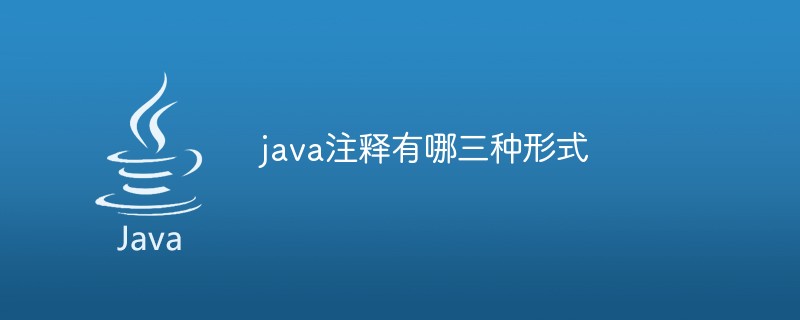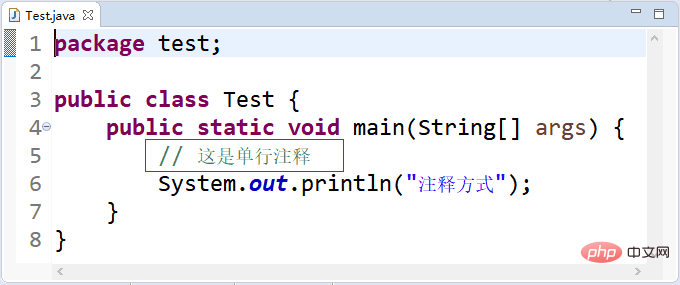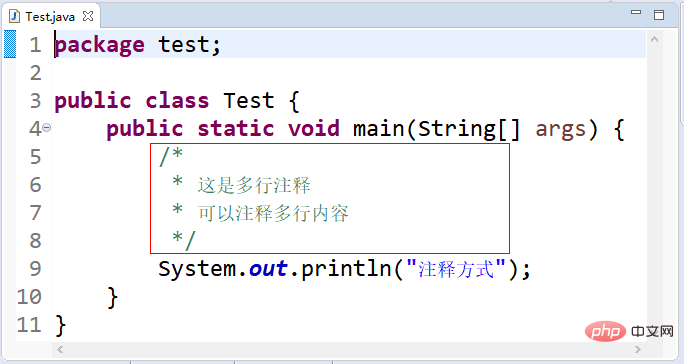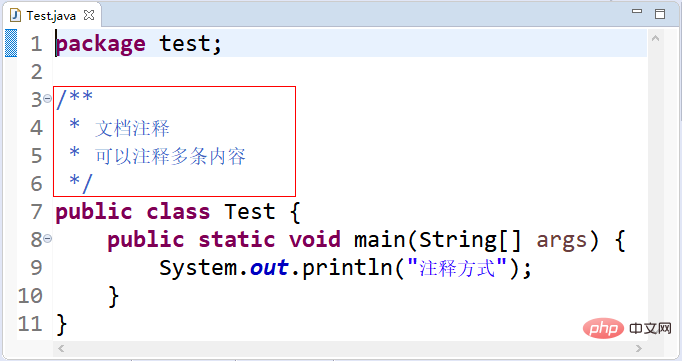*/". 3. Document comments, included between "/**"and"*/", can also comment on multiple lines of content. They are generally used on classes, methods and variables to describe their functions. The syntax is "/**", the next one will also be scanned"*/".Three forms of java comments: 1. Single-line comments, marked with double slashes "http://", can only comment one line of content, and are used in places with little comment information. The syntax is "http://"and" ". 2. Multi-line comments, included between "/*Annotation content*/", can comment on many lines of content, the syntax is "/*
"and"

The operating environment of this tutorial: windows7 system, java8 version, DELL G3 computer.
Comments are descriptions of the programming language, which facilitate communication between developers and users and facilitate understanding of the program. Comments are not programming statements and therefore are ignored by the compiler. Java supports three comment methods:
1) Single-line comment
Identified by double slashes "
", only one line of content can be commented, and it is used in places with little information content. Open Eclipse and use single-line comments in the Java code, as shown in Figure 1. 
Figure 1 Single-line comment
2) Multi-line comment is included in "/* "and"
", many lines of content can be commented. For better readability, generally no comment information is written in the first and last lines (this is also more beautiful and beautiful), as shown in Figure 2.
Note: Multi-line comments can nest single-line comments, but multi-line comments and document comments cannot be nested. 
Figure 2 Multi-line comments
3) Documentation comments are included in "/**## "#&*/

In Java, a line of comments is identified by double slashes "http://"; multi-line comments are included between "/*&*/"; documentation comments are included between " /**&*/"between.
When the compiler executes to "http://", it will ignore all text after the line "http://"; when it executes to "/*", it will scan the next "*/" and ignore "/* &*/"; when executing to "/**&*/" and ignore any text content between "/**&*/".
For more programming-related knowledge, please visit: Programming Teaching
! ! ###The above is the detailed content of What are the three forms of java comments?. For more information, please follow other related articles on the PHP Chinese website!

Hot AI Tools

Undress AI Tool
Undress images for free

Undresser.AI Undress
AI-powered app for creating realistic nude photos

AI Clothes Remover
Online AI tool for removing clothes from photos.

Clothoff.io
AI clothes remover

Video Face Swap
Swap faces in any video effortlessly with our completely free AI face swap tool!

Hot Article

Hot Tools

Notepad++7.3.1
Easy-to-use and free code editor

SublimeText3 Chinese version
Chinese version, very easy to use

Zend Studio 13.0.1
Powerful PHP integrated development environment

Dreamweaver CS6
Visual web development tools

SublimeText3 Mac version
God-level code editing software (SublimeText3)

Hot Topics
 Applying Semantic Structure with article, section, and aside in HTML
Jul 05, 2025 am 02:03 AM
Applying Semantic Structure with article, section, and aside in HTML
Jul 05, 2025 am 02:03 AM
The rational use of semantic tags in HTML can improve page structure clarity, accessibility and SEO effects. 1. Used for independent content blocks, such as blog posts or comments, it must be self-contained; 2. Used for classification related content, usually including titles, and is suitable for different modules of the page; 3. Used for auxiliary information related to the main content but not core, such as sidebar recommendations or author profiles. In actual development, labels should be combined and other, avoid excessive nesting, keep the structure simple, and verify the rationality of the structure through developer tools.
 The requested operation requires elevation Windows
Jul 04, 2025 am 02:58 AM
The requested operation requires elevation Windows
Jul 04, 2025 am 02:58 AM
When you encounter the prompt "This operation requires escalation of permissions", it means that you need administrator permissions to continue. Solutions include: 1. Right-click the "Run as Administrator" program or set the shortcut to always run as an administrator; 2. Check whether the current account is an administrator account, if not, switch or request administrator assistance; 3. Use administrator permissions to open a command prompt or PowerShell to execute relevant commands; 4. Bypass the restrictions by obtaining file ownership or modifying the registry when necessary, but such operations need to be cautious and fully understand the risks. Confirm permission identity and try the above methods usually solve the problem.
 Differences Between Callable and Runnable in Java
Jul 04, 2025 am 02:50 AM
Differences Between Callable and Runnable in Java
Jul 04, 2025 am 02:50 AM
There are three main differences between Callable and Runnable in Java. First, the callable method can return the result, suitable for tasks that need to return values, such as Callable; while the run() method of Runnable has no return value, suitable for tasks that do not need to return, such as logging. Second, Callable allows to throw checked exceptions to facilitate error transmission; while Runnable must handle exceptions internally. Third, Runnable can be directly passed to Thread or ExecutorService, while Callable can only be submitted to ExecutorService and returns the Future object to
 How Java ClassLoaders Work Internally
Jul 06, 2025 am 02:53 AM
How Java ClassLoaders Work Internally
Jul 06, 2025 am 02:53 AM
Java's class loading mechanism is implemented through ClassLoader, and its core workflow is divided into three stages: loading, linking and initialization. During the loading phase, ClassLoader dynamically reads the bytecode of the class and creates Class objects; links include verifying the correctness of the class, allocating memory to static variables, and parsing symbol references; initialization performs static code blocks and static variable assignments. Class loading adopts the parent delegation model, and prioritizes the parent class loader to find classes, and try Bootstrap, Extension, and ApplicationClassLoader in turn to ensure that the core class library is safe and avoids duplicate loading. Developers can customize ClassLoader, such as URLClassL
 Exploring Different Synchronization Mechanisms in Java
Jul 04, 2025 am 02:53 AM
Exploring Different Synchronization Mechanisms in Java
Jul 04, 2025 am 02:53 AM
Javaprovidesmultiplesynchronizationtoolsforthreadsafety.1.synchronizedblocksensuremutualexclusionbylockingmethodsorspecificcodesections.2.ReentrantLockoffersadvancedcontrol,includingtryLockandfairnesspolicies.3.Conditionvariablesallowthreadstowaitfor
 Handling Common Java Exceptions Effectively
Jul 05, 2025 am 02:35 AM
Handling Common Java Exceptions Effectively
Jul 05, 2025 am 02:35 AM
The key to Java exception handling is to distinguish between checked and unchecked exceptions and use try-catch, finally and logging reasonably. 1. Checked exceptions such as IOException need to be forced to handle, which is suitable for expected external problems; 2. Unchecked exceptions such as NullPointerException are usually caused by program logic errors and are runtime errors; 3. When catching exceptions, they should be specific and clear to avoid general capture of Exception; 4. It is recommended to use try-with-resources to automatically close resources to reduce manual cleaning of code; 5. In exception handling, detailed information should be recorded in combination with log frameworks to facilitate later
 What is the purpose of the `static` keyword in Java?
Jul 05, 2025 am 02:36 AM
What is the purpose of the `static` keyword in Java?
Jul 05, 2025 am 02:36 AM
Static keywords are used in Java to create variables and methods that belong to the class itself, rather than instances of the class. 1. Static variables are shared by instances of all classes and are suitable for storing data shared by all objects, such as schoolName in the Student class. 2. Static methods belong to classes and do not depend on objects. They are often used in tool functions, such as Math.sqrt(), and can only access other static members. 3. Static code blocks are used to perform initialization operations when class loading, such as loading libraries or setting logs. 4. Static inner classes can be instantiated independently of the external class, but non-static members of the external class cannot be accessed. Rational use of static can effectively manage class-level resources and behaviors.
 Explained: Java Polymorphism in Object-Oriented Programming
Jul 05, 2025 am 02:52 AM
Explained: Java Polymorphism in Object-Oriented Programming
Jul 05, 2025 am 02:52 AM
Polymorphism is one of the core features of Java object-oriented programming. Its core lies in "one interface, multiple implementations". It implements a unified interface to handle the behavior of different objects through inheritance, method rewriting and upward transformation. 1. Polymorphism allows the parent class to refer to subclass objects, and the corresponding methods are called according to the actual object during runtime; 2. The implementation needs to meet the three conditions of inheritance relationship, method rewriting and upward transformation; 3. It is often used to uniformly handle different subclass objects, collection storage and framework design; 4. When used, only the methods defined by the parent class can be called. New methods added to subclasses need to be transformed downward and accessed, and pay attention to type safety.






